Ellen and Jim Have a Blog, Too
We are two part-time academics. Ellen teaches in the English department and Jim in the IT program at George Mason University.


A political & a womens' film: _Religulous_ & _The Duchess_ · 13 October 08
Dear Friends,
Last week Yvette and I saw a costume film worth seeing, and this week Caroline came with us to see a political film. I write about them this morning, beginning with the second. Why begin with the second? Because Sarah Palin could get to be president of the United States and much of her popularity stems from her identification as living amid evangelical religious delusions and hypocrisies.
Read Jonathan Raban’s piece on her in the LRB, and then sit through Religulous. Bill Maher is a pop comedian who wants to show how bad for us is religion and challenges people, asking them why they believe in this or that absurdity (mostly stories from the Christian & Jewish Bible).
I said sit through because it’s not an easy film to watch: it’s embarrassing, like watching Queen for a Day in the 1950s on TV, to witness the dull and stupid expose themselves pathetically. The level of individual argument in the scenes was poor; it seemed to consist of Maher pointing out the impossibility of some of the stories in the Bible or the wealth accruing to the particular supposedly numinous person, and the interlocutors saying nothing much to that, denying they were rich or asserting it’s good to be rich. Most witnesses giving testimony were working class or lower middle class. So there is a class bias in the exposure: the upper middle class might be represented in the religious leaders but they are not presented in this light, only in the light that they make money and dress very well.
Three exceptions: one senator smiled in a smirky way; a man running a creationism museum looked mean; a man running a place which was intended to convert homosexuals. These three people provided scenes which were the most effective and powerful moments of the film: the senator was an utter hypocrite, amoral; the museum owner and man running a house against homosexuality had eyes & faces glinting with hatred and intolerance. I could see these latter two hurting others with pleasure. The senator would do & say anything to stay in power and remain wealthy.
Another technique of exposure was to reveal the show quality, fictional theater of churches themselves: we visit the Vatican for example; we see preachers demanding money; theme parks a la Disney have caught on: in all these places real people dress up in outfits and put on plays which are self-evidently inadequate, unreal, foolish, and money-making:
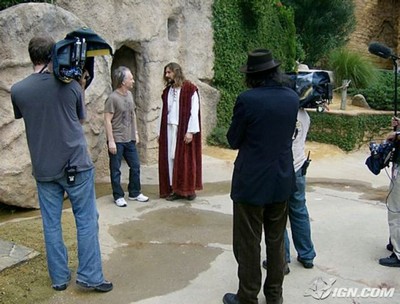
Maher interviewing actor at theme park
It seems that in these theme parks actual people and stage sets are preferred to movies.
One interest for me is how many people justified religious belief by saying they had experienced a miracle, how many full-grown 20th century adults seemed to turn to these kinds of delusions as proof there is a supernatural—it’s no wonder Hume began there, began with really cogent arguments against such nonsense. Maher also exposed charlatans who grow rich and powerful (dangerously) on religion. He did throughout the film “cover” himself by claiming to be agnostic: he doesn’t know. So still it’s not allowable to be an open atheist in pop culture. There is no intellectual or rational argument on behalf of living firmly on the basis of experience and probability as the only safety & sanity.
Maher’s larger argument is religion leads to cruel wars, exploitation of all sorts because the person is taught not to examine what is in front of him or her. He addressed those who don’t believe in the supernatural in any visceral or literal way. The audience was made up of people who laughed at his jokes. His last peroration was addressed to the timid who are agnostic (or atheistic) and are afraid to speak up. The idea is we are many and should not be cowed, because it is dangerous to let the fanatical shape the world.
The reply would be, on a one-to-one basis any challenge ends in a ferocious defense on the part of religious people. They are threatened (finally I think) because the belief is fragile with nothing to back it up, and everything around them against it except some feeling they inculcated usually very young of an indwelling benign presence taking care of them. No one is going to be argued out of religious belief. Death as annihilation is fearful. The notion that one learns a pragmatic morality by experiencing consequences in the context of a future where we can’t know what will be all the consequence makes no appeal to emotions. Life is hard and religious belief that somehow all is and will be well somewhere helps people get through.
So it might seem absurd to make such a film, but not in the US context. The importance of the film is simply it was made and there were enough people in the audience to keep it in the theatre this weekend. Those who go are not religious, but it shows there are growing numbers of such people in the US and perhaps that they are worried about the new spirit of aggressive evangelicalism.
I’ve seen this where I teach: young people present themselves as part of a beleaguered sect called Christianity. Some are intolerant of anything which goes against their beliefs—movies. Some determinedly give talks which proselytize their religion and turn books into treatises where God punishes those who don’t believe. Finally, some are not ashamed to present their experience of miracles in public. Ultimately many have been taught there is no public neutral space where private religion doesn’t belong and liberty of thought is a central norm.
In the NYRB lately there have been people writing firmly about how they live with no religious belief out of the same idea as Maher. It’s important to stand out and be counted as someone who doesn’t not live according to intolerant delusions, fear of death, fear of angry gods, or seek to impose their beliefs on others. As Sarah Palin does: to get back to her, she would impose on my vagina what she does with hers. Maher is right: religion is dangerous when we non-religious people let the knaves and fools get power and act virulently and corruptly.
*******************
The Duchess is a woman’s film of the costume drama type. I’ve already blogged here about the difference between Amanda Foreman’s book, Betty Rizzo’s account of the relationship of Lady Elizabeth Foster and Georgiana Spencer Cavendish, as well as the life and poetry of the real woman Georgiana (complete with paintings, a link to Diana Birchall’s blog on her interview of Foremand, and stills from the movie). So this is a continuation of those blog. Alas, I have yet to write about Harriet O’Carroll’s Aristocrats. I mean to eventually :)
On just the movie (which Yvette and I saw last weekend), we both liked it despite some real flaws. Let me say the problems first. These involve the reality that there really was such a woman and this is non-fiction material, not a novel (or romance). So the Duchess is shown gambling but it’s not central as it really was in her life. The real Duke punished her strongly for debts that even with his income were not trivial. The politicking was ludicrously superficial. In reality Bess and Geogiana were lovers and Georgiana dependent on Bess; it was not the case that Bess initiated Georgiana lightly and then Georgiana was livid over Bess’s affair with the Duke. Georgiana apparently accepted it, and Bess’s children by the Duke. I suppose lesbianism and bisexuality is thought beyond mass audiences.
The movie shows modern obsessions in other women’s films (Juno, There She found Me, the list gets longer each week): again we have these women traumatized by having biological children taken from them. Never mind the Duchess had a passel of them by the Duke; the climactic scene is when she has to turn over Grey’s baby to his family. Why this obsession is all over the movies in the last 3 years I leave to those interested in post-feminism: retreat with baby dear? into a cloud cuckoo never-never land. (Amanda Foreman’s piece on her difficult pregnancy belongs to this as well as her reversal on her own complicated book.) Thinking about it, it seems to me the subtext of all these grief striken women wanting a biological child, hysterical because a biological child is taken from them are anti-adoption. This becomes explicit in lots of non-costume dramas in the last few years, and of interest and importance is how the adoption agency people recognized this attack in Juno (it’s also in ostensibly male films, e.g., Last Orders). In The Duchess time is taken out to show the Duchess adopting the Duke’s child by another woman. This is super magnanimous of her.
In today’s world of serial monogamy, where families are not biologically related in traditional ways, this show unease with modern non-traditional families, a kind of pathological reflection or obsession resembling today’s crazed-up religions.
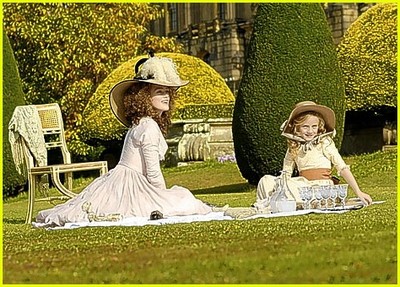
Holkham Hall glimpsed from the side.
It’s very typical not to be able to find stills of the landscape or houses on the Net though that’s partly what people watch for. When I went looking for a still of Holkham Hall, all that I could find was this tiny side view. All that is put out for popular consumption are stills of the stars, and it’s revealing here we have Keira Knightley and (in the fiction) her adopted daughter.
And of course the horrors of childbirth at the time, the dangers, were nowhere to be seen. We hear of two miscarriages and stillbirths but see nothing of it. Our glamorously anorexic sexy icon (Knightley) emerges from a succession of childbirths apparently wholly untouched, unscathed, as pretty as a picture, as if she dropped them on the way to the party. In reality her life was shortened by so many pregnancies.
So why did I like it? For a costume drama, it’s feminist and shows just how powerful the patriarchy was, and the real miseries of the position of a coerced woman. This was consistent and beautifully done throughout. We see Georgiana turned over to him for breeding; later she is raped by him. I was moved by the depiction of this young girl sold. In the story of Georgiana and Grey we had a version of what we see in the novels of the period (S&S) with our lovers, Grey and Georgiana pushed into giving up what they valued in private life for worldly position (he becomes prime minister), security, for her these children she doesn’t want to desert (that was believable). Dominic Cooper as Grey was a reluctant sincere Willoughby forced to marry money, land, position. We see Geogiana turned into an alcoholic (she drinks like a fish); that’s why she did turn to gambling. One of the most effective memorable scenes was of her wig catching on fire as she pranced about the room. Candles everywhere are expensive and dangerous.
The scenes had many visible implicit ironies; I liked it because it was melancholy and came out (unlike Aristocrats) by default on the side of rebellion even if the movie had the Duke assert things will never change and I will always be in charge or someone like me. I think that too had resonance for today—a bitter one.
The film began with a childlike race: Georgiana betting on Grey; it ends with Georgiana herself turned back into a child as she and Bess chase their children round a fountain. And then there were the cards with comments on what happened to our characters and some were sharply ironic. The film means to expose the personal hollowness of the life of Georgiana as a cause for her having become a devoted (using that religious term ironically) saloniere and politicking woman.
Now this serious set of themes made it more or equally successful with the comparable mini-series film, Harrriet O’Carroll’s Aristocrats (from Stella Tillyard’s book) which slid over many of these things that women endured (Aristocrats made a reactionary episode of Tillyard’s really fine Citizen Lord.)
The Duchess was beautiful as costume dramas often are. The dresses and costumes, the houses. They filmed on three places in Bath (you have to pay for each place in Bath you film and it’s high so we got just three places over and over again). I wondered if Chatsworth was being used for “Devonshire House.” On C18-l I was reliably informed that “The house used in the film as the main rotunda of Devonshire House in London was actually Holkham House in Norfolk, a William Kent design. Burlington, who promoted Palladianism, was one of Kent’s patrons.”
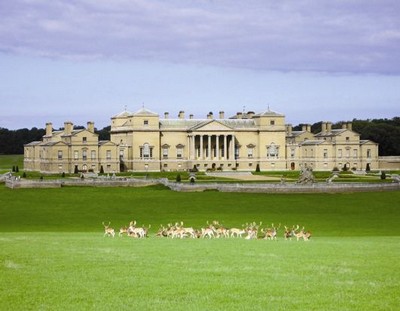
Holkham Hall (it is hard to find on the Net good photos of this place which are downloadable)
It was a BBC product with actors I recognized (but can’t name) playing character parts with aplomb. Quality drama in the houses and lovely landscapes. As a woman’s film (as Pam Cook argues in her book on costume dramas, Fashioning the Nation), it’s fascinating to see Keira Knightley continually dressed in imitation of Gainsborough paintings. One of the first British studios dedicated to producing costume dramas was called Gainsborough Studios, and its mascot (and trademark) was the woman dressed up as a Gainsborough portrait, often on a horse. An escape you see to beauty, luxury, adoration, adventure.
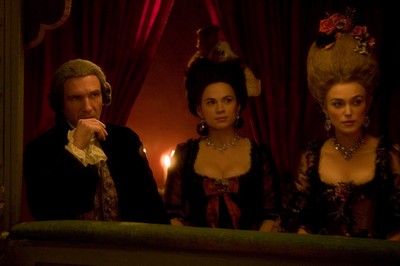
Ralph Fiennes, Keira Knightley, Hayley Atwell in historically accurate costumes which allow for this visual presentation of a menage a trois
I admit I am attracted to the type Fiennes plays in most of his films and love his subtle really studied and consistent way of acting all his roles.
As Diana remarked, the script by Jeffrey Hatcher, Anders Thomas Jenson and Saul Dibb left a lot to be desired. They conceived of the Duke as inarticulate, but the lines were often flat; though I’ve not studied them but my impression of Harriet O’Carroll’s Aristocrats was that the script was excellent, (especially the first couple of parts) giving many of the actors real depth and suggestions to work with.
I thought the acting was fine: Fiennes was “out of character” until near the end when the duke was made a softer character—he usually is the sensitive helper male—but he was believable and got some of the strongest laughs with his curt comeuppances and raw truth-telling. There the script was funny because he played it so as to evoke laughter and grimaces. Charlotte Rampling had too little to do as the Duchess’ mother; so too Hayley Atwell as Bess Foster. Keira Knightley was wrong physiologically but she acted her part very well, as did Dominic Cooper as Charles Grey, here not a thug as in Andrew Davies 2008 adaptation of Austen’s S&S, but rather the rough idealist.
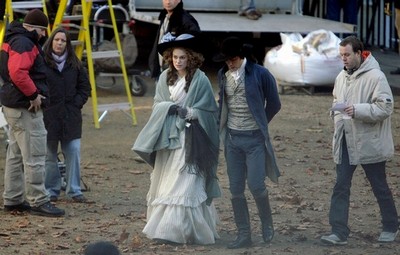
The still of them on the set reveals how we are to see them as a decent quiet thoughtful couple. Fugitives from a Jane Austen film? they remind me of Emma Thompson and Hugh Grant walking together; if Keira’s tightly-pulled shawl (such a thin woman would be cold) were to fall, he’d surely catch it before it reached the ground.
Ellen
--
Posted by: Ellen
* * *
Comment
- I enjoyed reading this.:) Unfortunately I seem to have missed seeing The Duchess at the cinema – I’ve been busy the last couple of weeks and couldn’t tempt anyone else in my family to go! – but I’m hoping it may turn up again. If not, will definitely see it on DVD. Holkham is in my part of the world but I haven’t been there for more than 20 years – we’ve just checked and unfortunately it is only open for guided tours of the house at the moment, without the chance to look round the grounds, but Paul and I are hoping to go there next spring, by which time I will hopefully have seen the movie…
— Judy Oct 13, 4:15pm # - From Clare:
“I really liked the posting on your site Ellen. It made me more determined to see the film when it eventually gets to Torquay. I liked how you highlighted the feminist & ironic aspects of the film. I’m really looking forward to seeing it for myself.
Clare”
— Elinor Oct 14, 3:46pm #
commenting closed for this article
